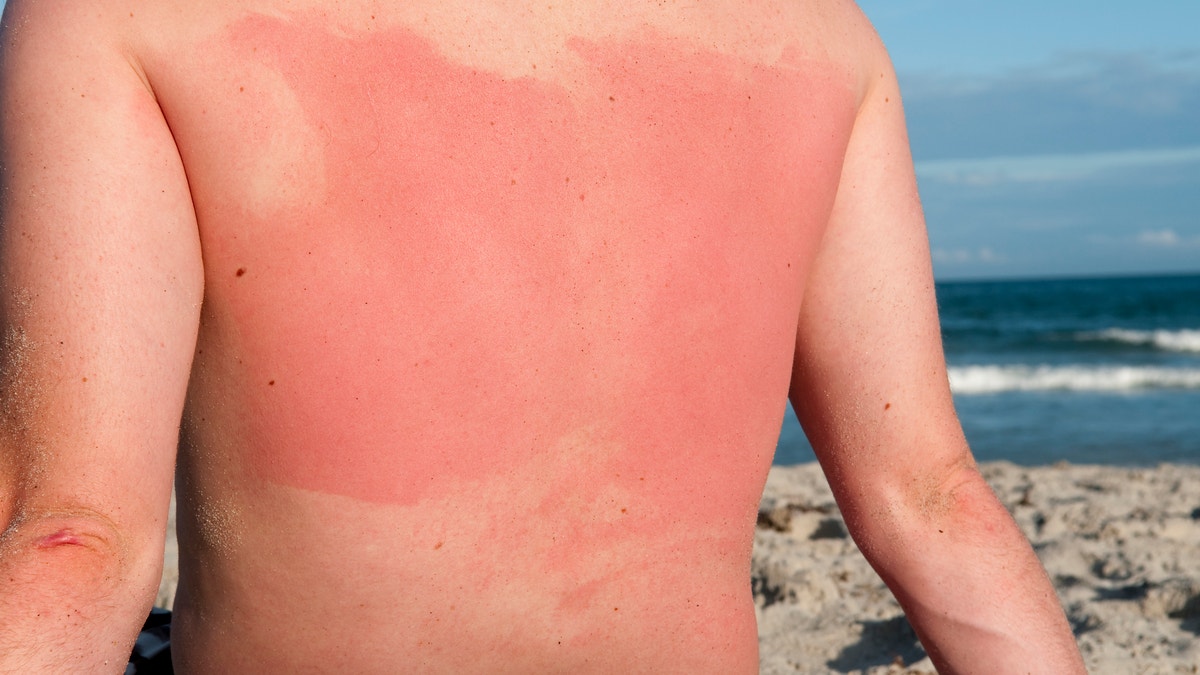
"A man with sunburn on the beach, the skin burnt where lotion didn't reach" (iStock)
This summer's must-reads aren't romances or thrillers; they're the warning labels and package inserts for your drugs and supplements. As Consumer Reports on Health warned in a recent article, “[s]ome widely used medications can make you far more sensitive to summer’s sunlight and heat than you’d usually be.”
RELATED: How to Exercise Safely in the Heat
That sensitivity can mean anything from a reduced ability to sweat to an increase in the amount of fluid you lose through your urine. So it’s important to revisit whatever safety info you have, and to check in with your doctor, who can let you know about potential risks during the brightest, warmest time of year, said Megan Rech, an emergency medicine clinical pharmacist at Loyola University Medical Center in Chicago.
“For the major players that interact with the sun and cause what’s called phototoxicity, those [effects] should be listed on the bottle or in the patient information," explained Rech. "But there are a lot of medications that can cause interactions with the sun, so lesser-known side effects [that] occur in fewer patients may not always be obvious."
Here are some of the better-known substances that may allow summer's sun and heat to hit you harder.
RELATED: Is It Risky to Drink While You're On Medication? Depends on the Drug
Acne treatments
“Those can definitely be phototoxic, especially the retinoids,” Rech said. “Phototoxic effects are going to appear like a really bad sunburn.”
The risk is more pronounced for prescription retinoids (such as Retin-A and Tazorac), which are significantly stronger than the products you’ll find at drugstores and beauty counters. But OTC acne and anti-aging products with retinol can cause dryness, peeling, and sun sensitivity as well. Products with salicylic acid and benzoyl peroxide can also increase your vulnerability. If you’re using one and plan to spend significant time outdoors, be sure to sport sunscreen and a broad-brimmed hat.
Antibiotics
“Antibiotics can cause photosensitivity and phototoxic reactions, meaning that they’re going to worsen your sunburn,” Rech said. “The one that comes to mind right away is Bactrim, or sulfamethoxozole trimethoprim.”
Bactrim is prescribed to treat everything from bronchitis to bladder infections. “That’s a big offender, and so are tetracyclines and fluoroqinolones.”
That said, you should never, ever skip an antibiotic for the sake of sunbathing, warned Rech. Your doctor can help you juggle your plans and your meds.
RELATED: What to Know about the ‘Heat Dome’ Settling Over Much of the U.S.
Allergy medications
Some users find that oral antihistamines like diphenydramine (found in products like Benadryl and Dramamine) reduce their ability to sweat. In extreme cases, as the Consumer Reports medical advisory board noted, the overheating that can result leads to cramps, exhaustion, and even heat stroke. If you find that your allergy meds make it difficult for you to cool down, plan outdoor activities for the morning and evening, and try to spend the hottest hours of the day indoors.
Antidepressants
Tricyclic antidepressants may cause problems in hot weather because they "prevent the area in your brain that regulates heat response from knowing you’re overheating,” Rech explained. “They can also decrease sweating, which leads to a decrease in heat loss.”
When you’re taking a drug that increases the likelihood of overheating, stay alert for warning signs such as headaches, lightheadedness, nausea, and weakness. If you experience any of those symptoms, get out of the sun and reach for water or a sports drink with sodium (which will help your body retain fluid until balance is restored). In the event of a severe reaction such as confusion, fever, or fainting, contact your doctor or call 911.
RELATED: How to Tell If You've Spent Too Much Time Out in the Heat
Non-steroidal anti-inflammatory drugs (NSAIDs)
“The main non-steroidals that cause phototoxicity are probably not ones that we commonly use," Rech said. But still, caution should be used, especially if you're on other medications.
"Any time you’re taking a non-steroidal and going out in the sun I would recommend barrier protection with sunscreen and avoidance if possible, because any of the non-steroidals can worsen [phototoxicity],” Rech explained.
Vitamins and herbs
“A lot of over-the-counter herbal medications [can have phototoxic effects]—for example, St. John’s Wort is a big inducer of photosensitivity, and that medication in particular has a number of drug interactions. Anyone [interested in taking it] should ask their doctor or pharmacist first,” Rech said.
Another pill that might put you at risk: Niacin, a form of Vitamin B3 that’s used to treat high cholesterol. It can cause skin reactions, Rech said, "so it could potentially cause [sun sensitivity].”
RELATED: 6 Big Myths About Hydration
Topical medications
Significant sun exposure can amplify the effect of transdermal patches (such as Fentanyl, a powerful pain reliever, or Clonidine, which lowers blood pressure) that deliver medication directly through the skin. When you get a sunburn, the blood vessels in the surface of your skin dilate, explained Rech, and that can lead to increased absorption of your meds. So if you’re wearing a patch, it's a good idea to consider long sleeves.